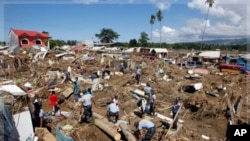Philippine President Benigno Aquino declared a state of national calamity on Tuesday, as authorities work to recover the bodies of those killed by flash floods on the southern island of Mindanao.
Disaster agency officials said Tuesday that 957 people have died so far as a result of the floods which began in the early hours of Saturday, while 49 others remain missing.
Officials said most of the damage was done in the southern port cities of Cagayan de Oro and Iligan, where mass graves are being prepared for hundreds of unidentified victims.
Sarah Williams interview with Richard Gordon, chairman of the Philippine Red Cross:
Iligan City Mayor Lawrence Cruz told the Reuters news agency the mass graves are necessary to prevent the spread of disease as a result of the decomposing bodies.
"We have decided, after consultation with our city health officer, that we should start digging graves for the bodies and bury them temporarily because they are already in an advanced state of decomposition," he stated. "People nearby might get sick if we do not bury the bodies.'
Officials have also reported a shortage of water and food at the island's overcrowded, makeshift evacuation centers. Almost 50,000 people who lost their homes remain in public shelters.
The flooding was caused by tropical storm Washi, which swept through the southern Philippines Friday evening, dropping a month's worth of rain in 24 hours.
Romeo Lozano, a farmer who reportedly saved 200 lives, told the Associated Press how people escaped the fury of the floods by rushing to his house rooftop. "If I had not opened our gate, many people would have died because they were already waiting and wanted to go upstairs. When I opened it, they all rushed to go inside our house, there is a roof top and we were all safe there. 200 of them, mostly children and elderly," he said.
About 143,000 people were affected in 13 southern and central provinces.
The Office of Civil Defense says some 7,000 houses were swept away, destroyed or damaged.








